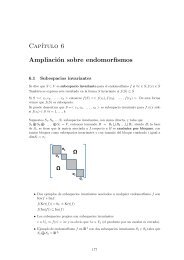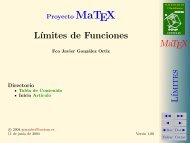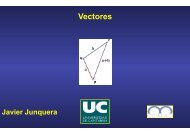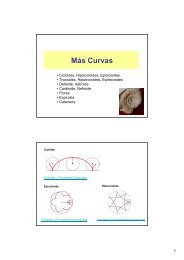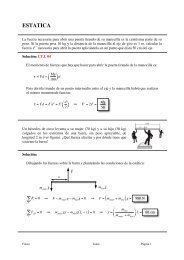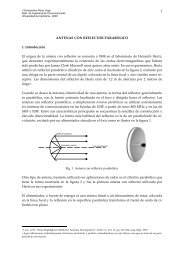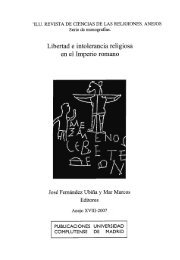Estimators based in adaptively trimming cells in the mixture model
Estimators based in adaptively trimming cells in the mixture model
Estimators based in adaptively trimming cells in the mixture model
Create successful ePaper yourself
Turn your PDF publications into a flip-book with our unique Google optimized e-Paper software.
Now, we are ready to prove <strong>the</strong> consistency of <strong>the</strong> procedure.<br />
PROOF OF THEOREM 4.5.- By Lemma 6.3 and <strong>the</strong> def<strong>in</strong>ition of ˆθ n , if n ≥ N 0 , we have<br />
IP n<br />
[<br />
Lˆθn/γ n<br />
]<br />
≥ IP n<br />
[<br />
LθP /γ n<br />
]<br />
→ IP<br />
[<br />
L θP /γ P<br />
]<br />
, (25)<br />
where <strong>the</strong> last convergence was stated <strong>in</strong> 5 <strong>in</strong> Proposition 6.2.<br />
Let us assume that (11) does not hold. By Corollary 6.4 <strong>the</strong> sequence {ˆθ n } n conta<strong>in</strong>s a subsequence<br />
such that<br />
lim<br />
n<br />
ˆθjn = θ ∗ = (π ∗ 1, ..., π ∗ k, φ ∗ 1, ..., φ ∗ k) ≠ θ P ,<br />
and θ ∗ ∈ Θ. From 2 and 3 <strong>in</strong> Proposition 6.2, we have that<br />
Lˆθjn /γ jn<br />
(Y jn ) →a.s. L θ∗ /γ P<br />
(Y 0 ). (26)<br />
However,<br />
Lˆθjn /γ jn<br />
(Y jn ) ≤ I Aγjn (Y jn ) log fˆθjn<br />
(Y jn ),<br />
which is a bounded function, and we can apply Fub<strong>in</strong>i’s Theorem to conclude that<br />
[<br />
] [ ]<br />
lim sup IP jn Lˆθjn /γ<br />
= lim sup ν Lˆθjn<br />
n<br />
jn<br />
/γ<br />
(Y jn ) ≤ ν L θ ∗ /γ<br />
n<br />
jn P<br />
(Y 0 ) = IP L θ ∗ /γ P<br />
. (27)<br />
Then, if we could prove that θ ∗ ∈ Θ γP ,u, we would have a contradiction between (27), (25) and <strong>the</strong><br />
uniqueness of θ P . To prove this, first notice that<br />
IP ˆθjn<br />
(i/Y jn )I Aγjn (Y jn ) →a.s. IP θ ∗(i/Y 0 )I AγP (Y 0 ). (28)<br />
As <strong>the</strong> functions IP θjn (i/·) are bounded by 1, we can apply 3 <strong>in</strong> Proposition 6.2 to have<br />
]<br />
uIP<br />
[A γP<br />
[ ]<br />
= lim uIP jn A γjn ≤ lim sup<br />
n n<br />
[<br />
]<br />
= lim sup ν IP ˆθjn<br />
(i/Y jn )I Aγjn (Y jn )<br />
[<br />
]<br />
≤ ν IP θ ∗(i/Y 0 )I AγP (Y 0 ) = IP<br />
IP jn<br />
[<br />
IP θjn (i/·)I Aγjn<br />
]<br />
[IP θ ∗(i/·)I AγP<br />
]<br />
,<br />
so <strong>the</strong> proof is complete because Corollary 6.4 implies that π ∗ i<br />
> 0 for every i = 1, ..., k.<br />
•<br />
PROOF OF THEOREM 4.8: After our consistency results, for <strong>the</strong> analysis of <strong>the</strong> asymptotic distribution,<br />
we can assume that <strong>the</strong> γ-parameters belong to a compact subset K of ˜Γ, as well as that <strong>the</strong> θ-parameters<br />
verify <strong>the</strong> restrictions given by Θ n γ,u and belong to <strong>the</strong> set {θ : ‖θ − θ 0 ‖ < δ} for some small enough δ > 0<br />
and large n.<br />
Now <strong>the</strong> proof parallels that given <strong>in</strong> [4] <strong>based</strong> on extended versions of <strong>the</strong> results <strong>in</strong> Section 3.2.4 <strong>in</strong> [21]<br />
to this semiparametric framework. In our case, for m θ,γ def<strong>in</strong>ed as <strong>in</strong> (12) <strong>the</strong> components of ṁ θ,γ := h θ,γ<br />
are those given <strong>in</strong> (14) with A γ as A. The result is <strong>the</strong>n <strong>the</strong> consequence of Lemma 6.5 similar to Lemma<br />
3.12 <strong>in</strong> [4]. From here, tak<strong>in</strong>g <strong>in</strong>to account Proposition 4.2 and some easy computations, obta<strong>in</strong><strong>in</strong>g <strong>the</strong><br />
asymptotic distribution given <strong>in</strong> <strong>the</strong> <strong>the</strong>orem as well as its different expressions is straightforward. •<br />
27




